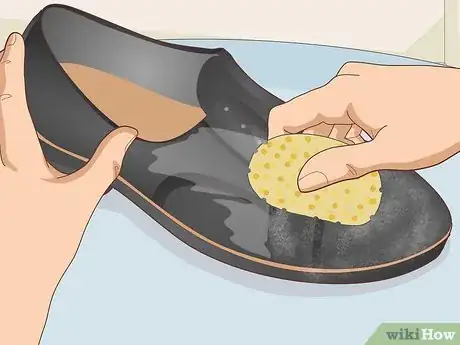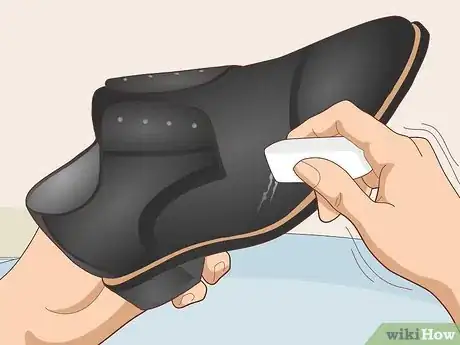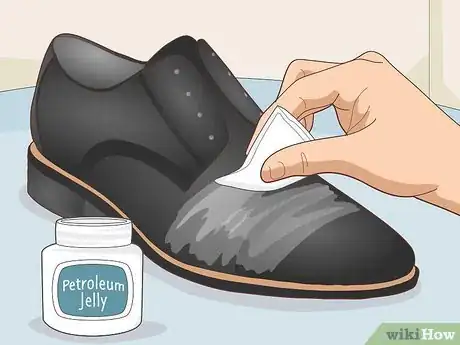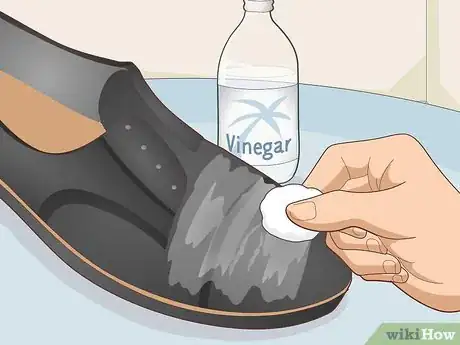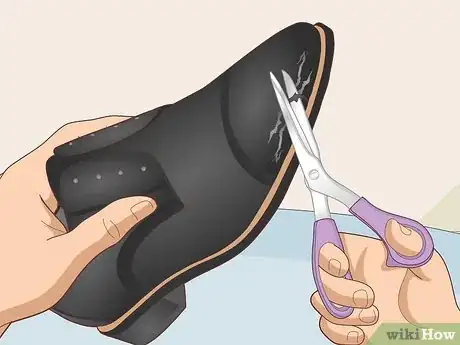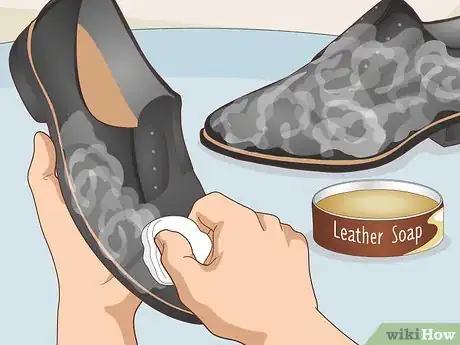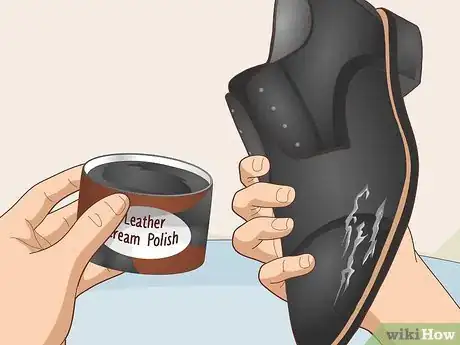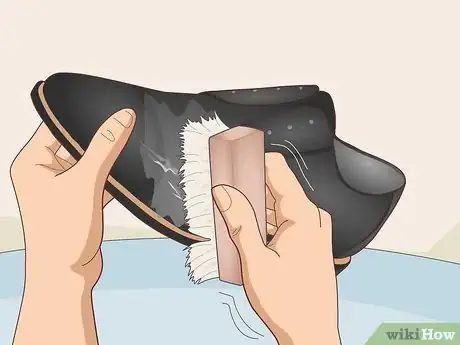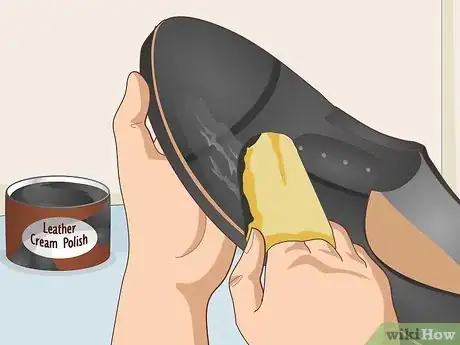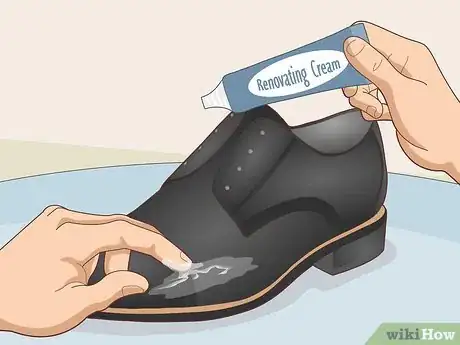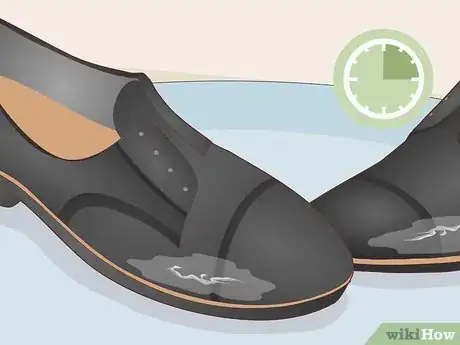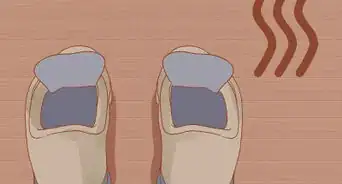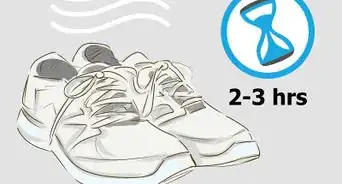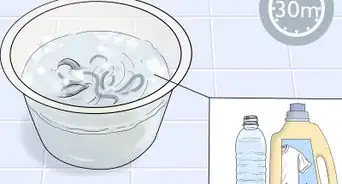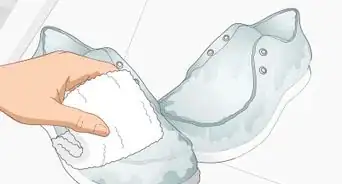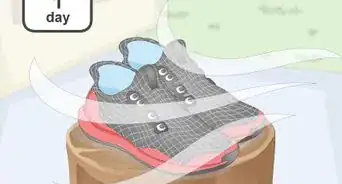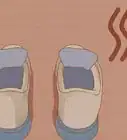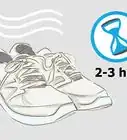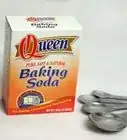This article was co-authored by Marc Sigal. Marc Sigal is the Founder of ButlerBox, a dry cleaning and shoe care service based in Los Angeles, California. ButlerBox places custom-designed, wrinkle-resistant lockers in luxury apartment buildings, class A office buildings, shopping centers, and other convenient locations so you can pick up and drop off items 24 hours a day, 7 days a week. Marc has a BA in Global and International Studies from the University of California, Santa Barbara.
There are 12 references cited in this article, which can be found at the bottom of the page.
This article has been viewed 24,306 times.
When cared for properly, a good pair of leather shoes can last you for many years. Make sure to repair them whenever they start to show signs of wear in the form of scuffs and scratches to prolong the lifespan of the shoes. For minor surface scuffs and scratches, try using some quick fixes that don’t require any special products. Use specialty shoe repair and leather care products to fix more serious, deeper scuffs and scratches to bring your shoes back to life.
Steps
Using Quick Fixes for Minor Scuffs
-
1Clean the shoes off with a damp sponge. Wet a clean sponge with water and wring out the excess so it isn’t dripping. Wipe down each shoe thoroughly to remove any dirt from the leather.[1]
- Remove the shoelaces if they get in the way of cleaning the shoes or if you need to fix scuffs and scratches near the laces.
-
2Erase light surface scuffs with a white rubber eraser. Gently rub the eraser back and forth or in circular motions over light scuffs and superficial scratches, applying gentle pressure. Use a dry soft cloth to wipe away the rubber particles when you’re done. Repeat the process until you can’t see the marks anymore.[2]
- This method works on many types of leather, including suede. If it doesn’t work, the scuffs might be too deep and you will need to try a different method.
Advertisement -
3Heat minor scuff marks up with a hair dryer and massage them away. Set the hairdryer’s heat setting to medium-hot and blow the warm air at the scuff marks for 10-15 seconds. Gently massage the marks into the leather by rubbing them with your fingertips using circular motions. Repeat this until the scuffs are gone.[3]
- You can also use a soft, clean cloth to buff the scuff marks into the leather instead of your fingers.
- To find the ideal temperature on the hair dryer, blow it at your hand first. If it is uncomfortable, it is too hot for the leather and you need to lower the heat. If your hand can comfortably bear it, the temperature is OK for the leather.
Warning: Make sure your hands are clean before you massage the scuff marks or you might end up making them worse by rubbing dirt or grit into the leather.
-
4Polish surface scuffs away with petroleum jelly. Dab the corner of a soft, clean cloth into a tub of unscented, uncolored petroleum jelly. Rub petroleum jelly into the scuffed surface using circular motions, then leave it for 10 minutes. Use a clean part of the cloth to wipe away excess jelly after 10 minutes.[4]
- Since petroleum jelly acts similarly to shoe polish, you can buff it with a shoe brush or soft cloth after it’s dry to shine up the spot you just repaired.
-
5Dab white vinegar on light scuffs before polishing to hide them. Use a cotton ball or cotton swab to dab white vinegar onto the scuffed areas. Let it dry completely, then polish the shoes with a colorless shoe polish.[5]
- Make sure that the cotton ball or swab is just damp, not dripping, with vinegar when you dab the vinegar onto the scuffs.
Fixing Deeper Scuffs and Scratches
-
1Cut off any leather that’s hanging off the shoes with sharp scissors. Examine the damaged areas to see if there are any tags of leather hanging off. Use a pair of sharp, fine-pointed scissors to snip the loose pieces of leather off.[6]
- This will smooth out the damaged areas to get them ready to clean and repair.
-
2Clean the leather with leather soap. Rub a clean, damp cloth into a tin of leather soap in a circular motion until it starts to look lathered. Vigorously wipe down the entire leather surface of each shoe with the soap, making sure to get into any cracks and crevices. Use a clean part of the damp cloth and more leather soap as needed as the cloth turns dark.[7]
- Leather soap is also known as saddle soap. You can get it in many shoe stores, stores that sell leather products, or order it online.
- It’s normal for the shoes to look a slightly different color after you wash them with the leather soap. This happens because the soap removes oils and polishes as well as dirt.
- Leather soap gets absorbed by the leather as you work, so you don’t typically need to wipe it off. However, if there is any excess lather on the shoes when you are done, you can wipe it away with a clean cloth.
-
3Select a cream polish that closely matches the color of the shoes. Purchase 2-3 cream polishes in different shades that you think might match the color of the shoes. Test each one by applying a small dab to the scuffed area with a fingertip, then choose the cream polish that is closest to the color of the shoes.[8]
- For example, if the leather is a dark, rich red color, you could try out a mahogany cream polish, a burgundy cream polish, and a dark brown cream polish and see which one looks best.
- Cream polish is the best choice for repairing major scuffs and scratches on your shoes because it does a better job of nourishing, conditioning, renovating, and coloring the leather than wax polish does.
- Testing several polishes is the most sure way to find the best match for your shoes, since polishes usually look different once applied to the leather than they do in the jars. However, if you aren’t worried about getting a perfect match, you can just buy 1 color that looks close enough.
-
4Apply your chosen cream polish to the leather using a shammy. Put your index and middle fingers inside a clean part of the shammy and dip it into the shoe polish. Rub it all over the scuffed area and the rest of the shoe, using circular motions, until you have coated the entire surface evenly.[9]
- A shammy, or chamois, is a soft, absorbent cloth that is ideal for applying polish to shoes. You can get one at many shoe stores or order one online. Alternatively, you can use any soft cotton cloth, such as a piece of an old cotton T-shirt.
-
5Buff the polish off the shoes with a horsehair brush. Hold one of the shoes firmly in your non-dominant hand and hold the horsehair brush in your dominant hand. Brush the entire leather surface of the shoe using vigorous back and forth motions to buff the polish off. Repeat this for the other shoe.[10]
- You can get a horsehair shoe brush at a shoe store or online. They are ideal for buffing polished shoes because horse hair is soft enough to not scratch the leather, but sturdy enough to buff it well.
-
6Apply additional coats of polish until you are happy with how the shoes look. Use the shammy to apply another even coat of cream polish to the shoes. Buff it off with the horsehair brush. Repeat this as many times as needed until the scuffs and scratches look filled in and repaired.[11]
- Depending how deep the scuffs and scratches in the leather are, 2-3 coats of polish is typically enough.
- Keep in mind that it is normal for the color of the leather to look a few different shades after polishing them, giving them a kind of natural antique look.
-
7Fill in any marks that are still showing with renovating repair cream. Squeeze a dab of renovating repair cream onto the tip of one of your index fingers. Gently dab it in to any deep scratches and scuff marks that are still showing.[12]
- Renovating repair cream is a special clear, resin-based repair cream that fills in deep scuff marks and scratches in leather. You can purchase it at a shoe store, a store that sells leather products, or online.
- If there are any areas of the leather that are still particularly discolored after polishing, you can also lightly dab the cream on top of these areas to help conceal them. For example, the toes of shoes are often areas that end up standing out in a different color than the rest of the leather.
-
8Let the renovating repair cream dry for 15 minutes. Set the shoes aside and wait at least 15 minutes for the repair cream to dry. The cream will be dry after 15 minutes and you can put the final touches on the repaired leather shoes.[13]
-
9Apply a final coat of polish on top of the repair cream. Use your shammy to rub another even coat of polish over the leather, paying special attention to the areas you just repaired with the renovating repair cream. Buff the final coat of polish off with your horsehair brush.[14]
- This will help blend in any deep scuffs and scratches that you just filled with the repair cream.
Tip: If you want to give the shoes a more antiqued look and blend the repaired areas in even more, use a slightly darker pigment of polish for this final coat.
Expert Q&A
-
QuestionHow can I prevent scuffs on my leather shoes?
 Marc SigalMarc Sigal is the Founder of ButlerBox, a dry cleaning and shoe care service based in Los Angeles, California. ButlerBox places custom-designed, wrinkle-resistant lockers in luxury apartment buildings, class A office buildings, shopping centers, and other convenient locations so you can pick up and drop off items 24 hours a day, 7 days a week. Marc has a BA in Global and International Studies from the University of California, Santa Barbara.
Marc SigalMarc Sigal is the Founder of ButlerBox, a dry cleaning and shoe care service based in Los Angeles, California. ButlerBox places custom-designed, wrinkle-resistant lockers in luxury apartment buildings, class A office buildings, shopping centers, and other convenient locations so you can pick up and drop off items 24 hours a day, 7 days a week. Marc has a BA in Global and International Studies from the University of California, Santa Barbara.
Shoe Care Specialist Buy a protective leather cream or wax and apply it to your leather shoes. Apply the product with a brush or microfiber towel in a circular motion, then buff your shoes with a brush.
Buy a protective leather cream or wax and apply it to your leather shoes. Apply the product with a brush or microfiber towel in a circular motion, then buff your shoes with a brush. -
QuestionDo you clean leather shoes before polishing them?
 Marc SigalMarc Sigal is the Founder of ButlerBox, a dry cleaning and shoe care service based in Los Angeles, California. ButlerBox places custom-designed, wrinkle-resistant lockers in luxury apartment buildings, class A office buildings, shopping centers, and other convenient locations so you can pick up and drop off items 24 hours a day, 7 days a week. Marc has a BA in Global and International Studies from the University of California, Santa Barbara.
Marc SigalMarc Sigal is the Founder of ButlerBox, a dry cleaning and shoe care service based in Los Angeles, California. ButlerBox places custom-designed, wrinkle-resistant lockers in luxury apartment buildings, class A office buildings, shopping centers, and other convenient locations so you can pick up and drop off items 24 hours a day, 7 days a week. Marc has a BA in Global and International Studies from the University of California, Santa Barbara.
Shoe Care Specialist Yes. If you polish dirty shoes, you may accidentally push the grime into the leather.
Yes. If you polish dirty shoes, you may accidentally push the grime into the leather. -
QuestionWhat is leather conditioner used for?
 Marc SigalMarc Sigal is the Founder of ButlerBox, a dry cleaning and shoe care service based in Los Angeles, California. ButlerBox places custom-designed, wrinkle-resistant lockers in luxury apartment buildings, class A office buildings, shopping centers, and other convenient locations so you can pick up and drop off items 24 hours a day, 7 days a week. Marc has a BA in Global and International Studies from the University of California, Santa Barbara.
Marc SigalMarc Sigal is the Founder of ButlerBox, a dry cleaning and shoe care service based in Los Angeles, California. ButlerBox places custom-designed, wrinkle-resistant lockers in luxury apartment buildings, class A office buildings, shopping centers, and other convenient locations so you can pick up and drop off items 24 hours a day, 7 days a week. Marc has a BA in Global and International Studies from the University of California, Santa Barbara.
Shoe Care Specialist Leather conditioner keeps your shoes supple so the leather doesn't dry out and crack.
Leather conditioner keeps your shoes supple so the leather doesn't dry out and crack.
Warnings
- Make sure your leather shoes are clean before polishing or scrubbing them so you don't accidentally push debris into the leather.[17]⧼thumbs_response⧽
Things You’ll Need
Using Quick Fixes for Minor Scuffs
- Sponge
- Water
- White rubber eraser
- Hair dryer
- Petroleum jelly
- White vinegar
- Colorless shoe polish
Fixing Deeper Scuffs and Scratches
- Sharp scissors (optional)
- Leather soap
- Soft cloth
- Cream shoe polish
- Shammy
- Horsehair brush
- Renovating repair cream
References
- ↑ https://www.thetrendspotter.net/how-to-shine-and-polish-shoes/
- ↑ https://www.shoehero.com/fix-scratched-leather/
- ↑ https://www.shoehero.com/fix-scratched-leather/
- ↑ https://www.shoehero.com/fix-scratched-leather/
- ↑ https://www.modainpelle.com/be-inspired/2019/04/how-to-repair-scuffed-leather-shoes-and-boots/
- ↑ https://www.youtube.com/watch?v=BRG1OiO75kg&feature=youtu.be&t=196
- ↑ https://www.businessinsider.com/heres-how-repair-your-leather-shoes-2015-4
- ↑ https://www.youtube.com/watch?v=BRG1OiO75kg&feature=youtu.be&t=380
- ↑ https://www.youtube.com/watch?v=BRG1OiO75kg&feature=youtu.be&t=435
- ↑ https://www.youtube.com/watch?v=BRG1OiO75kg&feature=youtu.be&t=440
- ↑ https://www.youtube.com/watch?v=BRG1OiO75kg&feature=youtu.be&t=440
- ↑ https://www.youtube.com/watch?v=BRG1OiO75kg&feature=youtu.be&t=579
- ↑ https://www.youtube.com/watch?v=BRG1OiO75kg&feature=youtu.be&t=630
- ↑ https://www.youtube.com/watch?v=BRG1OiO75kg&feature=youtu.be&t=635
- ↑ Marc Sigal. Shoe Care Specialist. Expert Interview. 15 January 2020.
- ↑ Marc Sigal. Shoe Care Specialist. Expert Interview. 15 January 2020.
- ↑ Marc Sigal. Shoe Care Specialist. Expert Interview. 15 January 2020.
